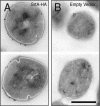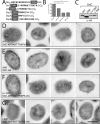Mechanism for sortase localization and the role of sortase localization in efficient pilus assembly in Enterococcus faecalis
- PMID: 19286802
- PMCID: PMC2687161
- DOI: 10.1128/JB.01837-08
Mechanism for sortase localization and the role of sortase localization in efficient pilus assembly in Enterococcus faecalis
Abstract
Pathogenic streptococci and enterococci primarily rely on the conserved secretory (Sec) pathway for the translocation and secretion of virulence factors out of the cell. Since many secreted virulence factors in gram-positive organisms are subsequently attached to the bacterial cell surface via sortase enzymes, we sought to investigate the spatial relationship between secretion and cell wall attachment in Enterococcus faecalis. We discovered that sortase A (SrtA) and sortase C (SrtC) are colocalized with SecA at single foci in the enterococcus. The SrtA-processed substrate aggregation substance accumulated in single foci when SrtA was deleted, implying a single site of secretion for these proteins. Furthermore, in the absence of the pilus-polymerizing SrtC, pilin subunits also accumulate in single foci. Proteins that localized to single foci in E. faecalis were found to share a positively charged domain flanking a transmembrane helix. Mutation or deletion of this domain in SrtC abolished both its retention at single foci and its function in efficient pilus assembly. We conclude that this positively charged domain can act as a localization retention signal for the focal compartmentalization of membrane proteins.
Figures






Similar articles
-
Acyl enzyme intermediates in sortase-catalyzed pilus morphogenesis in gram-positive bacteria.J Bacteriol. 2009 Sep;191(18):5603-12. doi: 10.1128/JB.00627-09. Epub 2009 Jul 10. J Bacteriol. 2009. PMID: 19592583 Free PMC article.
-
Sortase-mediated assembly and surface topology of adhesive pneumococcal pili.Mol Microbiol. 2008 Nov;70(3):595-607. doi: 10.1111/j.1365-2958.2008.06396.x. Epub 2008 Sep 17. Mol Microbiol. 2008. PMID: 18761697 Free PMC article.
-
Pilin and sortase residues critical for endocarditis- and biofilm-associated pilus biogenesis in Enterococcus faecalis.J Bacteriol. 2013 Oct;195(19):4484-95. doi: 10.1128/JB.00451-13. Epub 2013 Aug 2. J Bacteriol. 2013. PMID: 23913319 Free PMC article.
-
Rolling down the pilus formation of gram-positive bacteria: underlining the importance of Sortase C as a drug target.Biofouling. 2025 Jan;41(1):1-19. doi: 10.1080/08927014.2024.2426167. Epub 2024 Dec 10. Biofouling. 2025. PMID: 39654527 Review.
-
Pilus biogenesis of Gram-positive bacteria: Roles of sortases and implications for assembly.Protein Sci. 2017 Aug;26(8):1458-1473. doi: 10.1002/pro.3191. Epub 2017 May 15. Protein Sci. 2017. PMID: 28493331 Free PMC article. Review.
Cited by
-
A tale of two pili: assembly and function of pili in bacteria.Trends Microbiol. 2010 May;18(5):224-32. doi: 10.1016/j.tim.2010.03.002. Epub 2010 Apr 8. Trends Microbiol. 2010. PMID: 20378353 Free PMC article. Review.
-
Structural Insights into Substrate Recognition by Clostridium difficile Sortase.Front Cell Infect Microbiol. 2016 Nov 22;6:160. doi: 10.3389/fcimb.2016.00160. eCollection 2016. Front Cell Infect Microbiol. 2016. PMID: 27921010 Free PMC article.
-
Comprehensive analysis of phospholipids and glycolipids in the opportunistic pathogen Enterococcus faecalis.PLoS One. 2017 Apr 19;12(4):e0175886. doi: 10.1371/journal.pone.0175886. eCollection 2017. PLoS One. 2017. PMID: 28423018 Free PMC article.
-
Enterococcus faecalis Modulates Immune Activation and Slows Healing During Wound Infection.J Infect Dis. 2017 Dec 19;216(12):1644-1654. doi: 10.1093/infdis/jix541. J Infect Dis. 2017. PMID: 29045678 Free PMC article.
-
Electron Transport Chain Is Biochemically Linked to Pilus Assembly Required for Polymicrobial Interactions and Biofilm Formation in the Gram-Positive Actinobacterium Actinomyces oris.mBio. 2017 Jun 20;8(3):e00399-17. doi: 10.1128/mBio.00399-17. mBio. 2017. PMID: 28634238 Free PMC article.
References
-
- Campo, N., H. Tjalsma, G. Buist, D. Stepniak, M. Meijer, M. Veenhuis, M. Westermann, J. P. Muller, S. Bron, J. Kok, O. P. Kuipers, and J. D. Jongbloed. 2004. Subcellular sites for bacterial protein export. Mol. Microbiol. 531583-1599. - PubMed
-
- Caparon, M. G., B. Poolman, and A. Podbielski. 2007. Streptococcal peptide trans-membrane transport, p. 327-358. In R. Hakenbeck and S. Chhatwal (ed.), Molecular biology of the streptococci. Horizon Scientific Press, Norwich, United Kingdom.
-
- Carlsson, F., M. Stalhammar-Carlemalm, K. Flardh, C. Sandin, E. Carlemalm, and G. Lindahl. 2006. Signal sequence directs localized secretion of bacterial surface proteins. Nature 442943-946. - PubMed
Publication types
MeSH terms
Substances
Grants and funding
LinkOut - more resources
Full Text Sources
Molecular Biology Databases

